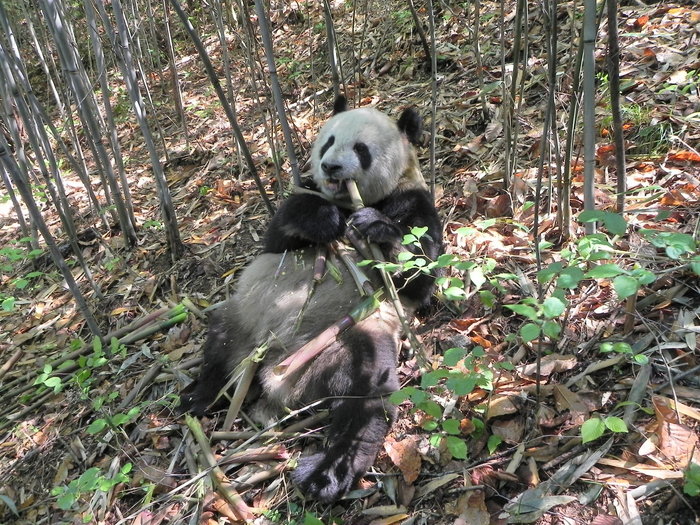The giant panda feeds exclusively on fibrous bamboo, yet they still manage to stay chubby and healthy. In a study published January 18 in the journal Cell Reports, researchers reveal that shifts in the bear’s gut microbiota in the season when nutritious bamboo shoots become available helps the herbivorous bear gain more weight and store more fat, which may compensate for the lack of nutrients in seasons when there are only bamboo leaves to chew on.

Credit: Fuwen Wei
The giant panda feeds exclusively on fibrous bamboo, yet they still manage to stay chubby and healthy. In a study published January 18 in the journal Cell Reports, researchers reveal that shifts in the bear’s gut microbiota in the season when nutritious bamboo shoots become available helps the herbivorous bear gain more weight and store more fat, which may compensate for the lack of nutrients in seasons when there are only bamboo leaves to chew on.
“This is the first time we established a causal relationship between a panda’s gut microbiota and its phenotype,” says first author Guangping Huang, at the Institute of Zoology, Chinese Academy of Sciences. “We’ve known these pandas have a different set of gut microbiota during the shoot-eating season for a long time, and it’s very obvious that they are chubbier during this time of the year.”
Many animals experience a seasonal shift in gut bacteria as a result of changes in food availability. For example, certain species of monkeys have different gut microbiota in summer when they get to eat fresh leaves and fruits compared with that in winter when they feed on tree bark. A similar shift is also observed in the Hadza people, who are modern hunter-gatherers living in Tanzania, as the type of available food changes throughout the year.
The team, led by Fuwen Wei at the Institute of Zoology, has been studying wild giant pandas living in the Qinling Mountains in central China for decades. For most time of the year, these animals feed on fibrous bamboo leaves. But during late spring and early summer, they get to enjoy newly sprouted bamboo shoots that are rich in protein.
Wei says that these wild pandas have a significantly higher level of a bacterium called Clostridium butyricum in their gut during the shoot-eating season compared with during the leaf-eating season. To investigate whether the change in gut microbiota could affect a panda’s metabolism, the team performed a fecal transplant of panda feces collected in the wild to germ-free mice. Then they fed the mice with a bamboo-based diet that simulated what pandas eat for 3 weeks.
Researchers found that mice transplanted with panda feces collected during shoot-eating season gained significantly more weight and had more fat than mice transplanted with feces from leaf-eating season despite consuming the same amount of food. Further analysis revealed that the metabolic product of C. butyricum, butyrate, could upregulate the expression of a circadian rhythm gene called Per2, which increases lipid synthesis and storage. The seasonal changes of the gut microbiota of pandas synchronize host peripheral circadian rhythm for modulating lipid metabolism.
“For endangered and vulnerable wild animals, we can’t really run tests on them directly. Our research created a mouse model for future fecal transplant experiments that can help study wild animals’ gut microbiota,” Huang says.
Next, the team plans to map out more microorganisms in the panda’s gut and find out about their roles in affecting the animal’s health. “Causal research of host phenotype and gut microbiota in wild animals is just beginning. Identifying what bacteria are beneficial for animals is very important, because one day we may be able to treat some diseases with probiotics,” Huang says.
·###
This work was supported by grants from the National Natural Science Foundation of China and the Strategic Priority Research Program of the Chinese Academy of Sciences.
Cell Reports, Huang, Wang, and Li et al.: “Seasonal shift of the gut microbiome synchronizes host peripheral circadian rhythm for physiological adaptation to a low-fat diet in the giant panda,” https://www.cell.com/cell-reports/fulltext/S2211-1247(21)01707-1
Cell Reports (@CellReports), published by Cell Press, is a weekly open-access journal that publishes high-quality papers across the entire life sciences spectrum. The journal features reports, articles, and resources that provide new biological insights, are thought-provoking, and/or are examples of cutting-edge research. Visit: http://www.cell.com/cell-reports. To receive Cell Press media alerts, contact [email protected].
Journal
Cell Reports
DOI
10.1016/j.celrep.2021.110203
Method of Research
Experimental study
Subject of Research
Animals
Article Title
Seasonal shift of the gut microbiome synchronizes host peripheral circadian rhythm for physiological adaptation to a low-fat diet in the giant panda
Article Publication Date
18-Jan-2022




